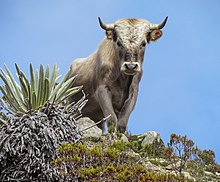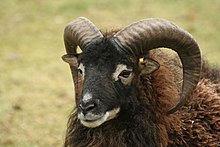This articleneeds additional citations forverification.(October 2015) |
Aferal(fromLatinfera'a wild beast')animalor plant is one that lives in the wild but is descended fromdomesticatedindividuals. As with anintroduced species,the introduction of feral animals or plants to non-native regions may disruptecosystemsand has, in some cases, contributed toextinctionofindigenous species.The removal of feral species is a major focus ofisland restoration.



Animals
editA feralanimalis one that has escaped from a domestic or captive status and is living more or less as a wild animal, or one that is descended from such animals.[1]Other definitions[2]include animals that have changed from being domesticated to being wild, natural, or untamed. Some common examples of animals with feral populations arehorses,dogs,goats,cats,rabbits,camels,andpigs.Zoologists generally exclude from the feral category animals that were genuinely wild before they escaped from captivity: neitherlionsescaped from a zoo nor thewhite-tailed eaglesre-introduced to the UK are regarded as feral.[3]
Plants
editDomesticatedplantsthat revert to wild are referred to as escaped, introduced,naturalized,or sometimes as feral crops. Individual plants are known as volunteers. Large numbers of escaped plants may become anoxious weed.The adaptive and ecological variables seen in plants that go wild closely resemble those of animals. Feral populations ofcropplants, along with hybridization between crop plants and their wild relatives, brings a risk thatgenetically engineeredcharacteristics such aspesticide resistancecould be transferred toweedplants.[4]The unintended presence ofgenetically modified cropplants or of the modified traits in other plants as a result of cross-breeding is known as "adventitious presence (AP)".[5][6]
Variables
editCertain familiar animals go feral easily and successfully, while others are much less inclined to wander and usually fail promptly outside domestication. Some species will detach readily from humans and pursue their own devices, but do not stray far or spread readily. Others depart and are gone, seeking out new territory or range to exploit and displaying active invasiveness. Whether they leave readily and venture far, the ultimate criterion for success islongevity.Persistence depends on their ability to establish themselves and reproduce reliably in the newenvironment.Neither the duration nor the intensity with which a species has been domesticated offers a usefulcorrelationwith its feral potential.[citation needed]
Species of feral animals
editThecatreturns readily to aferal stateif it has not been socialized when young. Feral cats, especially if left to proliferate, are frequently considered to be pests in both rural and urban areas, and may be blamed for devastating thebird,reptile,andmammalpopulations. A local population of feral cats living in an urban area and using a common food source is sometimes called aferal cat colony.As feral cats multiply quickly, it is difficult to control their populations. Animal shelters attempt to adopt out feral cats, especially kittens, but often are overwhelmed with sheer numbers andeuthanasiais used. In rural areas of the US, excessive numbers of feral cats are often shot.[7]The "trap-neuter-return"method has been used in many locations as an alternative means of managing the feral cat population.[7]
Thegoatis one of the oldest domesticated creatures, yet readily returns to a feral state.Sheepare close contemporaries and cohorts of goats in the history of domestication, but the domestic sheep is vulnerable topredationand injury, and thus rarely seen in a feral state. However, in places where there are few predators, they may thrive, for example in the case of theSoay sheep.Both goats and sheep were sometimes intentionally released and allowed to go feral on island waypoints frequented by mariners, to serve as a ready food source.
Thedromedarycamel, which has been domesticated for over 3,000 years, will also readily go feral.A substantial populationof feral dromedaries, descended from pack animals that escaped in the 19th and early 20th centuries, thrives in theAustralianinterior today.
Water buffalorun rampant in Western and Northern Australia. The Australian government encourages the hunting of feral water buffalo because of their large numbers.
Cattlehave been domesticated since theneolithicera, but can survive onopen rangefor months or years with little or no supervision.[8]Their ancestors, theaurochs,were aggressive, similar to the modernCape buffalo.Modern cattle, especially those raised on open range, are generally more docile, but when threatened can display aggression. Cattle, particularly those raised forbeef,are often allowed to roam quite freely and have established long term independence inAustralia,New Zealandand several Pacific Islands along with small populations of semi-feral animals roaming the southwestern United States and northernMexico.Such cattle are variously calledmavericks,scrubbers or cleanskins. Most free roaming cattle, however untamed, are generally too valuable not to be eventually rounded up and recovered in closely settled regions.
Horsesanddonkeys,domesticated about 5000 BCE, areferalin open grasslands worldwide. InAustralia,they are known asBrumbies;in theAmericanwest, they are calledmustangs.Other isolated feral populations exist, including theChincoteague Ponyand theBanker horse.They are often referred to as "wild horses",but this is a misnomer. There are truly" wild "horses that have never been domesticated, most notablyPrzewalski's horse.[9]While the horse was originally indigenous to North America, the wild ancestor died out at the end of thelast ice age.In both Australia and the Americas, modern "wild" horses descended from domesticated horses brought by European explorers and settlers that escaped, spread, and thrived. Australia hosts aferal donkey population,as do theVirgin Islandsand the American southwest.
Thepighas established feral populations worldwide, including in Australia, New Zealand, the United States,New Guineaand the Pacific Islands. Pigs were introduced to the Melanesian and Polynesian regions by humans from several thousand to 500 years ago, and to the Americas within the past 500 years. In Australia, domesticated pigs escaped in the 18th century, and now cover 40 percent of Australia,[10]with a population estimated at 30 million. While pigs are thought to have been brought to New Zealand by the original Polynesian settlers, this population had become extinct by the time of European colonization, and all feral pigs in New Zealand today are descendants of European stock.[citation needed]Many European wild boar populations are also partially descended from escaped domestic pigs and are thus feral animals within the native range of the ancestral species.[citation needed]
Rock doveswere formerly kept for theirmeator more commonly as racing animals and have establishedferal populationsin cities worldwide.
Colonies ofhoney beesoften escape into the wild from managedapiarieswhen theyswarm;their behavior, however, is no different from their behavior in captivity, unless they breed with other feral honey bees of a different genetic stock, which may lead them to become more docile or more aggressive (seeAfricanized bees).
Large colonies offeral parrotsare present in various parts of the world, withrose-ringed parakeets,monk parakeetsandred-masked parakeets(the latter of which became the subject of the documentary film,The Wild Parrots of Telegraph Hill) being particularly successful outside of their native habitats and adapting well to suburban environments.
Wild cocksare derived fromdomestic chickens(Gallus gallus domesticus) who have returned to the wild. Like thered junglefowl(the closest wild relative of domestic chickens), wild cocks will take flight and roost in tall trees and bushes in order to avoid predators at night. Wild cocks typically form social groups composed of, a dominant cockerel, several hens, and subordinate cocks. Sometimes the dominant cockerel is designated by a fight between cocks.[11]
Effects of feralization
editEcological impact
editA feral population can have a significant impact on an ecosystem by predation on vulnerable plants or animals, or by competition with indigenous species. Feral plants and animals constitute a significant share ofinvasive species,and can be a threat toendangered species.However, they may also replace species lost from an ecosystem on initial human arrival to an area, or increase the biodiversity of a human-altered area by being able to survive in it in ways local species cannot. Feralzebuhave been reintroduced inKuno Wildlife Sanctuaryin order to replace their ancestor, theaurochs.
Genetic pollution
editAnimals of domestic origin sometimes can produce fertile hybrids with native, wild animals which leads togenetic pollution(not a clear term itself) in the naturally evolved wild gene pools, many times threatening rare species withextinction.Cases include themallard duck,wild boar,therock doveor pigeon, thered junglefowl(Gallus gallus) (ancestor of allchickens),carp,and more recentlysalmon.[12][full citation needed]Other examples ofgenetic swampinglie in the breeding history ofdingoes.Dingoes arewild true dogsthat will interbreed with dogs of other origins, thus leading to the proliferation ofdingo hybridsand the possibility of the extinction of pure wild dingoes.[13]Researches in Scotland have remarked on a similar phenomenon of the genetic mi xing of feral domestic cats and their wild counterparts.[14]
Economic harm
editFeral animals compete with domestic livestock, and may degrade fences, water sources, and vegetation (byovergrazingor introducing seeds of invasive plants). Although hotly disputed, some cite as an example the competition between feral horses and cattle in the western United States. Another example is of goats competing with cattle in Australia, or goats that degrade trees and vegetation in environmentally-stressed regions of Africa. Accidental crossbreeding by feral animals may result in harm to breeding programs of pedigreed animals; their presence may also excite domestic animals and push them to escape. Feral populations can also pass on transmissible infections to domestic herds. Loss to farmers by aggressive feral dog population is common in India.
Economic benefits
editMany feral animals can sometimes be captured at little cost and thus constitute a significant resource. Throughout most ofPolynesiaandMelanesiaferal pigs constitute the primary sources of animal protein. Prior to theWild and Free-Roaming Horses and Burros Act of 1971,American mustangs were routinely captured and sold for horsemeat. In Australia, feral goats, pigs, horses, and dromedaries are harvested for the export for their meat trade. At certain times, animals were sometimes deliberately left to go feral, typically on islands,[citation needed]in order to be later recovered for profit or food use for travellers (particularly sailors) at the end of a few years.
Scientific value
editPopulations of feral animals present good sources for studies of population dynamics, and especially of ecology and behavior (ethology) in a wide state of species known mainly in a domestic state. Such observations can provide useful information for the stock breeders or other owners of the domesticatedconspecifics(i.e. animals of the same species).
Cultural or historic value
editAmericanmustangshave been protected since 1971 in part due to theirromanceand connection to the history of theAmerican West. A similar situation is that of theDanube Delta horsefrom theLeteaForest in theDanube Delta.TheRomaniangovernment is considering the protection of the feral horses and transforming them into a tourist attraction, after it first approved the killing of the entire population. Due to the intervention of numerous organizations and widespread popular disapproval of theRomaniansthe horses have been saved, but still have an uncertain fate as their legal status is unclear and local people continue to claim the right to use the horses in their own interest.[15]
See also
editReferences
edit- ^"Merriam-Webster On-line Dictionary".Retrieved23 October2013.
- ^Stevens, Sidney (September 14, 2020)."10 Feral Animals Wreaking Environmental Havoc".Treehugger.
- ^Lever, Christopher (1996). "Naturalized birds: feral, exotic, introduced or alien?".British Birds.89(8): 367–368.
- ^Bagavathiannan, M.V.; Van Acker, R.C. (2008), "Crop ferality: Implications for novel trait confinement",Agriculture, Ecosystems & Environment,127(1–2): 1–6,Bibcode:2008AgEE..127....1B,doi:10.1016/j.agee.2008.03.009
- ^Takeuchi, Masami,"Working Definitions"(PDF),Food Safety at FAO
- ^Hagler, J.R.; Mueller, S.; Teuber, L.R.; Machtley, S.A.; Van Deynze, A. (2011), "Foraging range of honey bees, Apis mellifera, in alfalfa seed production fields",Journal of Insect Science,11(1): 1–12,doi:10.1673/031.011.14401,PMC3281370,PMID22224495
- ^abDeak, Brooke P.; Ostendorf, Bertram; Taggart, David A.; Peacock, David E.; Bardsley, Douglas K. (September 2019)."The Significance of Social Perceptions in Implementing Successful Feral Cat Management Strategies: A Global Review".Animals.9(9): 617.doi:10.3390/ani9090617.ISSN2076-2615.PMC6770462.PMID31466221.
- ^Marvin, Garry; McHugh, Susan, eds. (2014).Routledge Handbook of Human-Animal Studies.Routledge International Handbooks.ISBN9780415521406.
- ^"Wild and feral horses".The Outer Banks Wild Horses.2016.
- ^Queensland Government."Feral pig".Primary industries & fisheries.Archived fromthe originalon 2011-03-12.
- ^Leonard, Marty L.; Zanette (1998)."Female mate choice and male behaviour in domestic fowl"(PDF).Animal Behaviour.56(5): 1099–1105.doi:10.1006/anbe.1998.0886.PMID9819324.S2CID45208700.Archived fromthe original(PDF)on 2005-05-15.Retrieved2008-04-25.
- ^Suk; et al. (February 2007).
{{cite book}}:Missing or empty|title=(help) - ^Fleming, Peter; Laurie Corbett; Robert Harden; Peter Thomson (2001).Managing the Impacts of Dingoes and Other Wild Dogs.Commonwealth of Australia: Bureau of Rural Sciences.
- ^Daniels, Mike J.; Laurie Corbett (2003). "Redefining introgressed protected mammals: when is a wildcat a wild cat and a dingo a wild dog?".Wildlife Research.30(3). CSIRO Publishing: 213.doi:10.1071/wr02045.
- ^"Noah's Ark – Project Horses Romania".Archived fromthe originalon February 20, 2012.
External links
edit- The dictionary definition offeralat Wiktionary